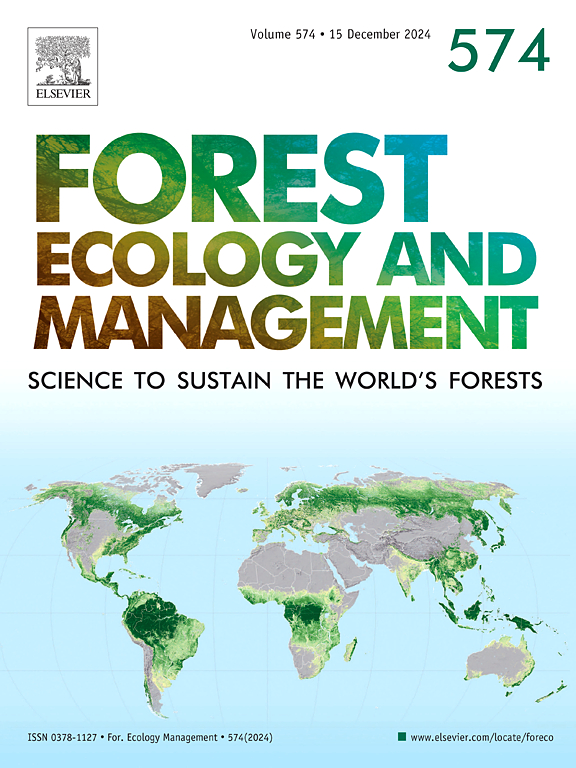在匈牙利喀尔巴阡山脉,缺乏大直径的活树和低结构多样性的管理干栎林的特点
IF 3.7
2区 农林科学
Q1 FORESTRY
引用次数: 0
摘要
橡树是各种森林类型的优势树种,具有重要的生态、经济和文化意义。森林结构和组成对森林功能和生物多样性有重要影响。它是自然度、碳储量的核心决定因素,可以成为森林管理的重要目标。研究了匈牙利喀尔巴阡山脉5个年龄级干栎林的组成和结构。收集不同林分的标准化数据,比较不同林龄(40 ~ 165年)和不同经营方式(管理-废弃)栎林的结构(密度、基面积、更新、枯枝、大小分布)和组成。使用一般线性混合模型分析年龄类别对衍生变量的影响,其中年龄类别为固定效应,区域为随机效应。林冠层各年龄层以栎树为主,栎树的相对基底面积在95 % ~ 99 %之间。林下的组成与冠层的组成差别很大,栎木在树龄和幼苗大小上都不占主导地位。小于120岁年龄组的胸高直径(DBH)范围平均超过28 cm,而最大年龄组的胸高直径达到45 cm。值得注意的是,大树(DBH >;60 cm)几乎不存在于管理的干松木林中。所有管理林分的平均每公顷大树数为0.2棵,而废弃林分(树龄超过120年)的平均每公顷大树数接近5棵。管理龄级林分直径分布呈钟形曲线,超过120年林分的林分直径呈双峰分布,次低峰出现在35 ~ 40 cm直径范围内。为了促进干中膜栎林向更自然的状态过渡,除了在砍伐后实施适当的更新技术外,还必须确保保存完整的地区和栖息地树木。建议保留贴片覆盖总面积的百分比在5% %到25% %之间。如果不留下这些未成熟的斑块,匈牙利的干梅西克栎林将继续缺少大树。本文章由计算机程序翻译,如有差异,请以英文原文为准。
Lack of large-diameter living trees and low structural diversity characterise managed dry-mesic oak forests in the Hungarian Carpathians
Oaks are the dominant species of a wide range of forest types and are of great ecological, economic and cultural importance. Forest structure and composition have a major influence on forest function and biodiversity. It is a core determinant of naturalness, carbon storage and can be an important goal for forest management. We investigated the composition and structure in five age classes of dry-mesic oak forests in the Hungarian Carpathians. We collected standardised data from different stands and compared the structure (density, basal area, regeneration, dead wood, size distribution) and composition of oak forests among different age classes (40–165 years) and by management type (managed – abandoned). The effect of age class on the derived variables was analysed using general linear mixed models with age class as a fixed effect and region as a random effect. Oaks dominated all age classes in the canopy layer, with the combined relative basal area of oaks ranging from 95 % to 99 %. The composition of the understorey was very different from that of the canopy, with oak not dominating either the sapling or seedling size classes in any of the age classes. The diameter at breast height (DBH) range for age classes younger than 120 years old exceeds 28 cm on average, while in the oldest age class it reaches 45 cm. It is notable that large trees (DBH > 60 cm) are practically absent from the managed dry-mesic oak stands. The mean number of large trees per hectare was found to be 0.2 for all managed stands, while in the abandoned stands (with an age of over 120 years old) it was close to 5 trees per hectare. The diameter distribution of managed age classes exhibits a bell-shaped curve, whereas stands exceeding 120 years of age display a double-peak pattern, with the lower secondary peak occurring within the 35–40 cm diameter range. In order to facilitate the transition of dry-mesic oak forests towards a more natural state, it is crucial to ensure the preservation of intact areas and habitat trees, in addition to implementing appropriate techniques for their regeneration following felling. It is recommended that retention patches cover a percentage of the total area that is between 5 % and 25 %. Without leaving such immature patches, large trees will continue to be absent from dry-mesic oak forests in Hungary.
求助全文
通过发布文献求助,成功后即可免费获取论文全文。
去求助
来源期刊

Forest Ecology and Management
农林科学-林学
CiteScore
7.50
自引率
10.80%
发文量
665
审稿时长
39 days
期刊介绍:
Forest Ecology and Management publishes scientific articles linking forest ecology with forest management, focusing on the application of biological, ecological and social knowledge to the management and conservation of plantations and natural forests. The scope of the journal includes all forest ecosystems of the world.
A peer-review process ensures the quality and international interest of the manuscripts accepted for publication. The journal encourages communication between scientists in disparate fields who share a common interest in ecology and forest management, bridging the gap between research workers and forest managers.
We encourage submission of papers that will have the strongest interest and value to the Journal''s international readership. Some key features of papers with strong interest include:
1. Clear connections between the ecology and management of forests;
2. Novel ideas or approaches to important challenges in forest ecology and management;
3. Studies that address a population of interest beyond the scale of single research sites, Three key points in the design of forest experiments, Forest Ecology and Management 255 (2008) 2022-2023);
4. Review Articles on timely, important topics. Authors are welcome to contact one of the editors to discuss the suitability of a potential review manuscript.
The Journal encourages proposals for special issues examining important areas of forest ecology and management. Potential guest editors should contact any of the Editors to begin discussions about topics, potential papers, and other details.
 求助内容:
求助内容: 应助结果提醒方式:
应助结果提醒方式:


